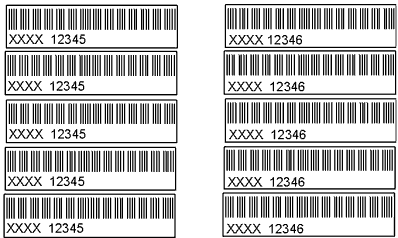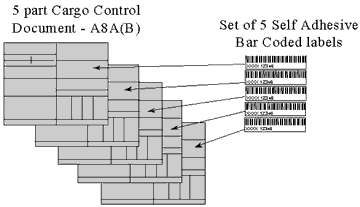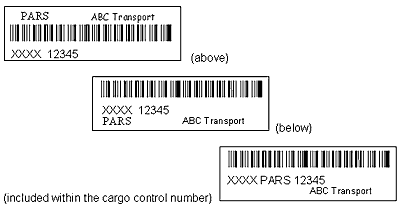In this section
Related links
Commercial Carrier and Freight Forwarder Identification and Eligibility
Cargo control and bar-coded labels
The carrier code is combined with a unique shipment number (chosen by the carrier) to create a cargo control number.
The cargo control number is critical because it identifies both the carrier and shipment to the CBSA at the time of reporting and when release documents are presented.
The cargo control number is used in bar-code format. For example, the carrier code "XXXX" plus the unique shipment number "12345" creates a cargo control number that looks like this:

Note: Highway carriers have 30 days after receiving their carrier code to obtain bar-coded labels. After the 30-day period, an administrative penalty of $1,000 will be imposed on carriers if bar-coded labels are not presented with their shipments upon arrival at the Canadian border.
Bar Code Printing Options for Carriers
The CBSA maintains a list of printing companies with CBSA-approved bar codes for cargo control numbers.
Printing option 1
Arrange to have your cargo control documents printed with your personal carrier code and a unique shipment number in bar-code format directly on the form. One of the advantages of having pre-printed forms is that you can also have your company name, logo, address and other relevant information on the form so that you don't need to type in the same information for every shipment.
Printing option 2
Arrange to have self-adhesive labels printed (in sets of five) with your personal carrier code and unique shipment number in bar-code format. These labels can then be attached to the blank five-page cargo control document available from the CBSA.
Example:

Note that the shipment number changes with each set of labels. Each shipment must have its own unique number and the numbers cannot be repeated within a three-year period. When ordering labels, be sure that you have enough unique shipment numbers to last you for three years.
Take one set of self-adhesive labels (all with the same shipment number) and place one label on each of the five pages of a blank cargo control document, Form A8A(B), in the space marked "Carrier code – Cargo control No." as illustrated below:

Option 3 – Using the Pre-Arrival Review System (PARS)
- The invoice/bill of lading must be sent to the broker at least two hours before the goods arrive in Canada.
- The PARS process must be used at an automated port (printing Option 1 or Option 2 (listed above) must be used if the port is not automated).
Unlike the multi-page cargo control document, the PARS process only requires one label per shipment. To identify a PARS shipment to the CBSA, the word "PARS" must appear on the bar-coded label. It may be printed either above the bar code or under the human-readable number below the bar code. If the word "PARS" is part of the cargo control number (i.e. between the carrier code and shipment number), the word must also be included in the actual bar code. The carrier's name or company logo may also be printed on the label.

The first four digits of the bar-coded label will be the personal carrier code followed by the word "PARS" (if included as part of the number) and a unique shipment number. Each shipment must be assigned a new number and the shipment numbers must not be repeated within a three-year period.
Using PARS and non-PARS (RMD) shipments
Regardless of the option you choose, the shipment number may not be repeated for a period of three years. If you use both service options, make sure that the numbers used for your PARS shipments and the numbers used for your RMD (release with minimal documentation) shipments are not the same. CBSA systems do not distinguish between the service options and will reject all duplicate numbers.
| PARS Number | RMD Number | Result | |
|---|---|---|---|
| XXXX 00001 | XXXX 00001 | = duplicate number | Rejected |
| XXXXPARS00001 | XXXX 00001 | = No duplication | OK |
| XXXX00001 | XXXX 50001 | = No duplication | OK |
The PARS bar-coded label may be applied to the invoice or to the bill of lading for the shipment. A cargo control document is not required unless the carrier gets a "Failed PARS" (see "Failed PARS procedures"). The carrier then faxes the invoice/bill of lading to the appropriate customs broker at the Canadian border. The driver should have the original bar-coded paperwork in hand when he or she arrives at the Canadian border.
If the invoice/bill of lading consists of more than one page, only one bar-coded label is needed on the first page; however, the pages should be numbered "page 1 of 4", "page 2 of 4" and so on. At the border, the CBSA officer will use a bar-code reader to scan the PARS label on the paperwork. If the shipment is cleared, the officer will date-stamp the invoice/bill of lading (not any other additional copies) and return it to the driver as proof of customs clearance. The shipment may then be delivered.
Failed PARS Procedures
There are times when a PARS shipment has not been processed by the time a carrier arrives at the border.
In these situations, the shipment is either released at the border using RMD or forwarded in bond. To avoid a duplicate release of these shipments, the cargo control number (CCN) submitted with the PARS request must be re-used on a cargo control document. The CCN must be handwritten or typed on a blank cargo control document, Form A8A(B). This form is free and can be ordered from the CBSA by email at forms-formulaires@cbsa-asfc.gc.ca.
Alternatively, carriers may use their own pre-printed cargo control documents and cross out the existing bar-coded number and type or neatly handwrite the original failed PARS number in the "Previous cargo control No." field. In either instance, the notation "Failed PARS" must be marked in the description field of the cargo control document.
The original invoice/bill of lading with the PARS bar-coded label should be given to the customs broker to include in the RMD package. This will allow CBSA officers to scan the bar code into the system instead of keying in information.
Please note that handwritten/typed CCNs on A8A(B) forms will only be accepted when a PARS procedure fails. Carriers will be subject to a penalty under the Administrative Monetary Penalty System if they fail to comply with the bar-code requirements for all other reporting and release processes.
Failed PARS shipments should not happen regularly. If this is the case, please check with your broker to identify and resolve the problem.
Bar Code Readability Testing
The CBSA maintains a list of printing companies with CBSA-approved bar codes for cargo control numbers. If you decide to use a printing company other than those on this list, original bar codes must be sent to the following address to be tested.
Sample bar-coded/human-readable cargo control numbers must be tested to ensure they meet departmental standards for readability. It is the responsibility of all companies, including the printing firms, to obtain initial approval of their bar codes and to resubmit samples whenever there is a change to the printing process or materials used. Original bar-coded document samples or bar-coded labels should be submitted for approval to the CBSA:
Bar Code Testing
Technical Commercial Client UnitEmail: tccu-ustcc@cbsa-asfc.gc.ca
Cargo Control Documents
To order the blank forms, please send an email to forms-formulaires@cbsa-asfc.gc.ca and ask for a supply of blank cargo control documents, form number A8A(B). There is no charge for these blank forms and usually a one-year supply is provided at a time.
Make sure that the numbers used for your PARS shipments and non-PARS shipments (referred to as Release on Minimum Documentation or RMD shipments) are not the same.
- Date modified: